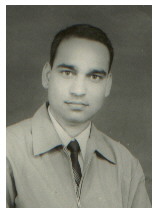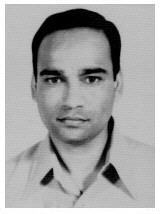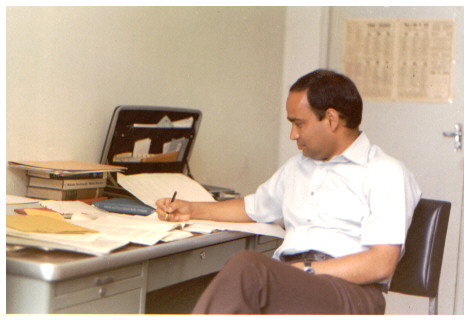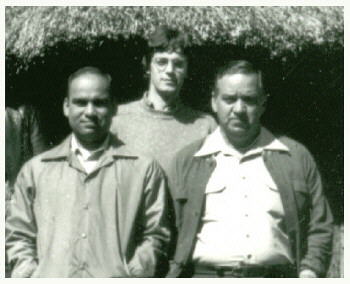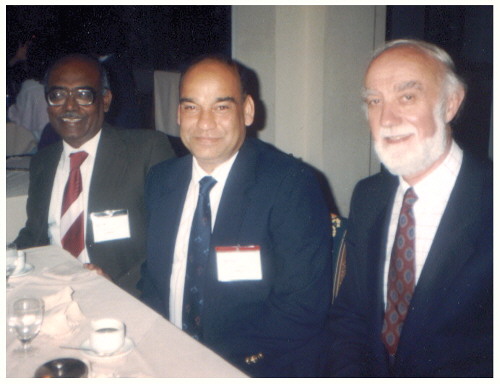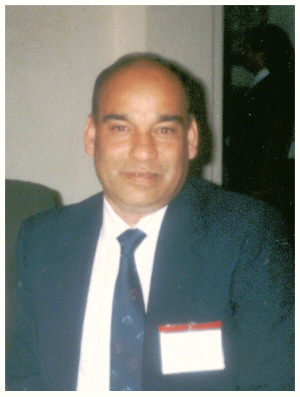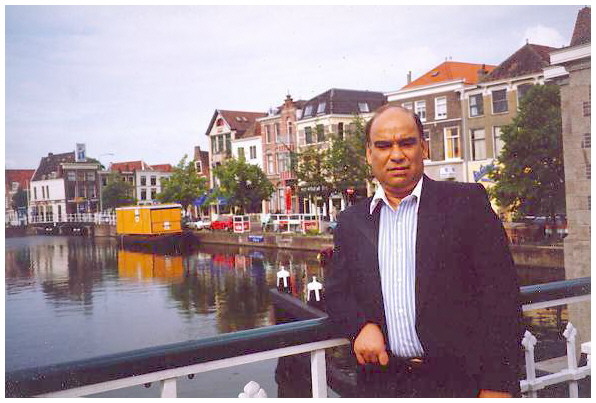INTRODUCTION
In 1972, the Institute of Astronomy and Geophysics (IAG), then an "Associate Institute", was formally converted into a unit of the São Paulo University (USP), consisting of the Departments of Astronomy, Geophysics and Meteorology, and offering graduate programs at the MSc and PhD levels.
This great change led the Director of IAG, Prof. Dr. Giorgio E.O. Giacaglia to advertise new positions in journals such as Science and Nature, looking for experienced researchers to reinforce the teaching staff, mainly in Astronomy. This procedure was successful, attracting several researchers among which: Calvin Morse Burgoyne, Charles Atkins Dean, Franklin Glenn VanLandingham, Vern Leroy Peterson and Bing Kang Cheng (Taiwan), all PhDs in Astronomy or Physics. Since Peterson was engaged to Aeronomy, he was assigned to Meteorology, and latter appointed head of the Department. This job opportunity also attracted Dipak Basu, who had worked before at the Mackenzie Center for Radio-Astronomy and Astrophysics (CRAAM) at Mackenzie University (São Paulo), and Patan Deen Singh, both from India.
Once finished the initial three year contract, practically all the members of this foreign legion went away, mainly back to USA, the home country of most of them, hoping to find better positions and research facilities. However, time has shown that this was a great illusion. After more than twenty-five years, none of them achieved an outstanding academic career, and some have even changed their professions, admiting that once they had crossed the Rio Grande, at the border between USA and Mexico, this was really the best opportunity they had in their lives, particularly in Astronomy.
P. D. Singh (1942-1999), photos from the period 1972-1976.
The only exception was Patan Deen Singh. Dr. Singh, then nearly 32 years old, arrived at IAG in September 1974, coming straight from India and trying to adapt himself fast to the Brazilian culture, up to the point of giving up at all the abstinence to beef, as is the tradition in Hinduism and becoming a great appreciator of barbecue. He bought a second-hand Chevette 74 from Basu, used it for more than 20 years, and was still able to sell it in good conditions.
EDUCATION
P.D. Singh, as he liked to be called, finished his BSc in Physics in 1960 at Gorakhpur University, India. In 1962 he earned his MSc in Physics in first place in his class, also at the same university. Following, he started his PhD in Physics under the advisorship of Prof. Devendra Sharma. Prof. Sharma, in turn, was a brilliant student of the famous German-Canadian spectroscopist Gerhard Herzberg (1904-1999), who received the Nobel Prize of Chemistry in 1971 "for his contributions to the knowledge of electronic structure and geometry of molecules, particularly free radicals". Patan earned his PhD in Physics with the dissertation Spectroscopic Studies of Simple Polyatomic and Diatomic Molecules, in 1967 from Gorakhpur University (Sharma et al. 1968).
His academic career started also at the same university as Assistant (1962-1965), holding the position of Lecturer between 1965 and 1972. Between 1972 and 1973 he was a post-doctoral fellow at the University of Electrocommunications in Tokyo, Japan. He used to say that the adaptation to the rigid Japanese diet started the process of his early baldness. Once, in the early 1980’s, Dr. Singh and Amaury de Almeida were in a long external corridor at the Physics Institute of the State University of Campinas (UNICAMP), when he said: "Do you see that Japanese man who is coming towards us over there at the end of the corridor? He looks familiar to me. I have seen that guy somewhere." What Amaury witnessed next was just a simple and happy proof that this is really a small world and the unexpected excitement of two old colleagues sharing a lot of memories: after all, they were post-doctoral fellows together in Japan and now by coincidence they were working in Brazil!
Back in India, Dr. Singh took on his position as Assistant Professor at the Physics Department of Gorakhpur University, where he stayed until coming to Brazil.
CONTRIBUTION
Along with his integration to the Brazilian culture, Dr. Singh accepted the natural challenge of trying to link his solid knowledge on molecular spectroscopy to the interests and needs typical to the research lines on Astrophysics which soon started being planned at the Astronomy Department. Due to his professional background, Dr. Singh tried first to develop laboratory conditions for his work on molecular spectroscopy of astrophysical interest. He spent several months studying catalogues, getting in touch with manufacturers and dealers, trying to define what would be the molecular counterpart of the laboratory research then performed at the IAG by Sayd Codina in the field of interstellar dust. Then he ended up with what probably was his first Brazilian disappointment: he found out that an experimental work starting from scratch would be almost impossible in Brazil those days, mainly due to the bureaucracy and lack of financial support. He gave up the original project but was not discouraged, and simply changed the focus of his research, now towards a theoretical and more feasible approach.
P. D. Singh at the IAG in 1974. (Photo: W. J. Maciel)
From this initial effort resulted his first astrophysical research paper (Singh, 1975). This was the very first contribution among those foreign researchers at the Astronomy Department. Starting from there, followed a series of papers published in the major journals, about simple molecular species of astrophysical interest, with the collaboration of several colleagues at the Department, initially with Walter Maciel and Frank VanLandingham (Singh & Maciel, 1976; Maciel & Singh, 1977; Singh & VanLandingham, 1978; Singh & Maciel, 1980).
P.D. Singh always had an aversion to the classical concept of research group and bureaucratic activities, but on the other hand, he was always open to collaborate with his colleagues (Singh et al. 1985; Singh & Gruenwald, 1987; Singh et al. 1989; Barbuy et al. 1993) and even with their own students. In the paper Schiavon et al. (1997) where the molecular bands of FeH were first sinthesized P.D. Singh contributed with the determination of Franck-Condon factors, then not available in the literature for this quite complex molecular system. The data set on FeH then in focus was the main point in the “Berkeley Newsletter”. The same paper was also cited for the spectral analysis of the dwarf M GL 229A, which is the companion of the well known brown dwarf GL 229B. For the PhD dissertation of Bruno Castilho, P.D. Singh contributed with the Franck-Condon factors of the molecules CN, CH, NH, and OH in the ultraviolet, for which only a meager data set was then available in the literature. This habit of sharing his knowledge, not only made him popular but also admired by his colleagues. Several of these papers were extracted from the MSc thesis of his students: Maria Lucia Quarta (Quarta & Singh, 1981), Elisabete M.G. Dal Pino (Dal Pino & Singh, 1984), Vera Jatenco Silva Pereira and Rose Marie Atalla (Atalla & Singh, 1987; Sinha et al. 1988). The student Regina M. Roveri (Roveri et al. 1988) only did not finished her MSc thesis simply due to her stubbornness and incompatibility of tempers with Dr. Singh, who on his turn, was always very demanding and strict with his students.
P. D. Singh, W. J. Maciel and P. Marques dos Santos, I Advanced School of Astrophysics, Campos do Jordão, 1981.
Several graduated courses were introduced and offered under his initiative: Atomic and Molecular Spectra, Molecular Astrophysics, Interstellar Molecules, and Astrochemistry of the Interstellar Medium. His research and lecture notes were always very clear, detailed, and he could write in any scrap paper such as on the back of an used envelope.
Besides, he sought to make contact and collaborations abroad. In March 1984, IAG had the visit of Prof. Alexander Dalgarno of Harvard-Smithsonian Center for Astrophysics (CfA). That is remarkable, since Prof. Dalgarno is well known worldwide for his contribution in the field of Atomic and Molecular Astrophysics, and his efforts to consolidate the modern field of Astrochemistry. Prof. Dalgarno offered a five weeks course on “Molecular Astronomy” which was attended also by graduate students from similar institutions, so opening our minds for this new branch of science which is growing very fast nowadays. On the other hand, Dr. Singh also visited CfA, collaborating with Prof. Dalgarno (Singh et al. 1983). Prof. Dalgarno visited again the Astronomy Department during the second semester of 1987 to give a series of seminars.
In December 1985, the IAU Symposium No. 120 took place in Goa (India) with about 120 participants. This was the first meeting on Astrochemistry getting together the main researchers worldwide in Molecular Astrophysics. From this meeting appeared the important Working Group on Astrochemistry (WGA) of Commission 34 (Interstellar Medium) in Division VI (Interstellar Matter) of IAU, of which Dr. Singh become a member ever since.
In the 1987 IAU General Assembly in Baltimore (USA), it was decided that the future symposia from the various commissions should take place right after and as close as possible from the host country of the next General Assembly. Since the 1991 General Assembly would take place in Buenos Aires (Argentina), Prof. Dalgarno persuaded Dr. Singh to accept the task to organize and host the second Symposium on Astrochemistry in São Paulo. The natural challenges of organizing an event of such importance got worse by a long period of high inflation and poor available infra-structure. Similar difficulties were also overcome by Beatriz Barbuy, who simultaneously organized, in August 1991, the IAU Symposium No. 149 “The Stellar Population of Galaxies” in Angra dos Reis (Rio de Janeiro), and by Sylvio Ferraz-Mello, who organized the IAU Symposium No. 152, “Chaos, Resonance and Collective Dynamical Phenomena in the Solar System”, in July of the same year, also in Angra dos Reis. Even so, the IAU Symposium No. 150 “Astrochemistry of Cosmic Phenomena” took place in the normal course of events and in the best scientific environment in Campos do Jordão (São Paulo). Twelve years after this very important event, two other Symposia on Astrochemistry took place: the IAU 178 “Molecules in Astrophysics: Probes and Processes” in Leiden (Holland), 1996, and the IAU 197 “Astrochemistry: From Molecular Clouds to Planetary Systems”, in the vulcanic island of Cheju (South Korea), 1999. As Secretary of the LOC to IAU Symposium No. 150 and having attended the other meeting, Amaury de Almeida still have heard compliments and the inevitable comparisons made by several people who also attended those meetings, to the symposium organized by Dr. Singh. In particular, the proceedings of this meeting, edited by him (Singh 1992) were very well accepted and recommended by the referee Jim Cohen, who considered the proceedings as “examplary” (Cohen, 1993).
S. P. Tarafdar, P. D. Singh e A. Dalgarno, IAU Symposium 150, Campos do Jordão, 1991. (Photo: A. A. de Almeida)
In 1992, Dr. J. Mayo Greenberg, professor emeritus at Leiden University (Holland), accepted the invitation from Dr. Singh to visit the Astronomy Department and give a graduate course on “Dust in the Universe” between October and November (Grenberg et al. 1993).
If an important component of astrochemical sources are the stellar atmospheres and the distant, dense and cold interstellar clouds of gas and dust, another is relatively closer, and represented by the Solar System, through the planetary and cometary atmospheres, also composed of gas and cosmic dust (de Almeida and Singh 1982).
P. D. Singh, IAU Symposium 150, Campos do Jordão, 1991. (Photo: A. A. de Almeida)
So, Dr. Walter F. Huebner from Southwest Research Institute (USA), a well known scientist on cometary physics, visited twice the Astronomy Department, becoming one of the closest collaborators of Dr. Singh (Singh et al. 1991). Between April and May 1988, Dr. Huebner gave a series of lectures on “Physics of Comets in the Space Era” at IAG. On the other hand, Dr. Singh also visited twice SwRI, the last time between 1992-1993 with Amaury de Almeida (de Almeida et al. 1997). Also Dr. Daniel C. Boice from SwRI, first visited IAG between September and November 1994. In December 1991, Dr. Singh made his public examination for a permanent position at USP, and less than six months later his public examination for professorship at IAG (equivalent to the “Doktor Habilis” in Germany) (Singh et al. 1992).
As a contribution to the administration of IAG, Dr. Singh took part very actively in the library committee during several years, and also participated in the committee of graduate programs, among others.
Under his advisorship, the following students received the PhD degree in Astronomy: Amaury A. de Almeida (de Almeida & Singh, 1986; de Almeida et al. 1989), Gilberto C. Sanzovo (Sanzovo et al. 1993; Sanzovo et al. 1996), and Carmen M. Andreazza (Andreazza et al. 1995; Andreazza and Singh, 1997).
Between 1998 and 1999 Dr. Alka Misra from the University of Lucknow (India), took her post-doctoral training at IAG under the supervision of Dr. Singh.
Besides the great friendship and comradeship, the long collaboration with J.A. de Freitas Pacheco and Sayd Codina also deserves to be mentioned. From there several papers appeared (de Freitas Pacheco et al. 1988; Landaberry et al. 1991; Singh et al. 1997).
P. D. Singh in Leiden, Holland, 1996. (Photo: A. A. de Almeida)
Dr. Singh effectively published 55 papers in refereed international journals, and his last contribution was in collaboration with Prof. Fernando R. Ornellas and Dr. Antonio C. Borin, from the Chemistry Institute (USP) (Singh et al. 1999). Once inquired by Amaury de Almeida, who was making his resumé for a Brazilian federal agency (CAPES), about which paper was considered by him as most important, he mentioned without any hesitation Costa et al. (1997). It makes sense: this work deals about the observation of the collision of fragment L from Comet Shoemaker-Levy 9 with Jupiter in 19 July 1994, performed at National Laboratory of Astrophysics (LNA) in Brazil, with the Perkin- Elmer 1.60 meter telescope. It was detected for the very first time the light and low abundant element Lithiun in comets. This result reveals a clear clue to the correlation, considering the standard cosmological model, between the cometary and interstellar matter, which in turn gave origin to the protosolar nebula. Almost a decade after this achievement we note that only a French group working independently at the Pic du Midi Observatory, in the French Pyrenees achieved similar results (Roos-Serote et al. 1995), definitely confirming this very important cosmogonical discovery. Today, we know 123 interstellar and circunstellar molecules (http://www.cv.nrao.edu/~awootten/allmols.html) out of which 108 (or about 88%) are also found in the recent comets Hale-Bopp (C/1995 O1) and Hyakutake (C/1996 B2), the two brightest comets in the past 20 years.
A few months later, when Dr. Singh was still trying to recover himself from a brain stroke, suffered on May 11, 1998, he had a second and stronger stroke on August 15, 1999, going into a process of deep and irreversible coma lasting for 54 days. His funeral occurred on October 10, 1999, at the same date of his birthday, when he would complete 57 years, at Peace Cometary in Diadema (São Paulo), where also lies our dear colleague, Dr. Maria Alcina Braz, as was his explicit desire to Amaury.
Among the many manifestations of sorrow received by Amaury de Almeida, it should be mentioned the one of Prof. David Williams from the University College London (UK), former president of AWG and Royal Astronomical Society, who pointed out the original contributions in Astrochemistry of Dr. Singh and praised his work in the organization of the IAU Symposium No. 150.
Conscious that he would not have physical conditions to make the long journey beyond Japan to South Korea, to attend IAU Symposium No. 197, he asked Amaury to order him a copy of the proceedings. This was a very tiring and lonely trip, full of worries and with several phone calls back home after informations about his health conditions and assistance. Due to the seriousness of the situation, during the meeting de Almeida asked the editors of the proceedings to include a tribute to Dr. Singh, what was accepted by Prof. Dr. Ewine van Dishoeck from Leiden Observatory (Holland), president of AWG.
On July 19, 1994, during the final match of the Soccer World Cup, when the Italian player Roberto Baggio lost that penalty and Brazil became the world champion, Roberto Costa, Patan and Amaury as mentioned before, were at LNA observing the collisions of Shoemaker-Levy 9 fragments with Jupiter and they witnessed his shout and jump for joy as a real Brazilian. Although he had formally applied a few times, Dr. Singh did not obtained the Brazilian citizenship. But this condition would make not much of a difference. He already was Brazilian in his heart a long time ago, following always with great interest the news and games of the Brazilian soccer team in several World Cups, the last in 1998 from the hospital at USP. In fact, he used to enjoy himself with the Brazilian TV novels, and was always ready to discuss different matters of IAG, on going research or of general nature with his colleagues, in a very pleasant way and in a good humor.
REFERENCES
Andreazza, C.M., Singh, P.D. 1997. Formation of SiC, Si2, CP, C2, C2+, and N2+ by radiative association. Mon. Not. R. Astron. Soc. 287, 287.
Andreazza, C.M., Singh, P.D., Sanzovo, G.C. 1995. The radiative association of C and S, C+ and S, Si and O, and Si+ and O. Astrophys. J. 451, 889.
Atalla, R.M., Singh, P.D. 1987. PO-Prospects in interstellar medium. Astrophys. Space Sci. 133, 267.
Barbuy, B., Schiavon, R.P., Gregorio-Hetem, J.C., Singh, P.D., Batalha, C. 1993. Intensity of CaH lines in cool dwarfs. Astron. Astrophys. Suppl. Ser. 101, 409.
Cohen, J. 1993. The Observatory: a review of astronomy, 113, 219.
Costa, R.D.D., de Freitas Pacheco, J.A., Singh, P.D., de Almeida, A.A., Landaberry, S.J.C. 1997. Atomic emission lines in the spectrum observed after the impact between the L-fragment of comet D/Shoemaker-Levy 9 and Jupiter. Astrophys. J. 485, 380.
Dal Pino, E.M.G., Singh, P.D. 1984. The 3410 A band of the PH molecule in the solar photospheric spectrum. Solar Phys. 90, 259.
de Almeida, A.A., Singh, P.D. 1986. Photodissociation lifetime of 32S2 molecule in comets. Earth, Moon and Planets 36, 117.
de Almeida, A.A., Singh, P.D. 1982. NH+ - A candidate for interstellar space and comets. Astron. Astrophys. 113, 199.
de Almeida, A.A., Singh, P.D., Burgoyne, C.M. 1989. Haser model CN, C2 and C3 production rates in some comets. Earth, Moon and Planets 47, 15.
de Almeida, A.A., Singh, P.D., Huebner, W.F. 1997. Water release rates, active areas and minimum nuclear radius derived from visual magnitudes of comets - An application to comet 46P/Wirtanen. Plan. Space Sci. 45, 681. 681.
de Freitas Pacheco, J.A., Landaberry, S.J.C., Singh, P.D. 1988. Spectroscopic observations of comet Halley during 1985-86 apparition. Mon. Not. R. Astron. Soc. 235, 447.
Greenberg, J. Mayo, Singh, P.D., de Almeida, A.A.1993. Astrophy. J. 414, L45.
Landaberry, S.J.C., Singh, P.D., de Freitas Pacheco, J.A. 1991. Ground based observations of comets Giacobini-Zinner (1984e) and Hartley-Good (1985l), Astron. Astrophys. 246, 597.
Maciel, W.J., Singh, P.D. 1977. The MgH molecule in the atmospheres of late type stars-transition probabilities, oscillator strengths and fine structures of rotation-vibration bands. Astron. Astrophys. 54, 417.
Quarta, M.L., Singh, P.D. 1981. A potential interstellar species: CS+. Astron. Astrophys. 98, 384.
Roos-Serote, M., Barucci, A., Crovisier, J., Drossart, P., Fulchignoni, M., Lecacheux, J., Roques, F. 1995. Metallic emission lines during the impacts L and Q1 of comet P/Shoemaker Levy 9 in Jupiter. Geophys. Res. Lett. 22, 1621.
Roveri, R.M., Ederly-Mendes, M., Singh, P.D. 1988. The SiN radical in interstellar clouds. Astron. Astrophys. 199, 127.
Sanzovo, G.C., Singh, P.D., Huebner, W.F. 1993. CS Band intensity and column densities and production rates of 15 comets. Astron. J. 106, 1237.
Sanzovo, G.C., Singh. P.D., Huebner, W.F. 1996. Dust colors, dust release rates, and dust-to-gas ratios in comets Bowell (1980b), Bradfield (1979 X), Brorsen Metcalf (1989o), Giacobini-Zinner (1984e), Levy (1990c), and Stephan-Oterma (1980 X). Astron. Astrophys. Suppl. Ser. 120, 301.
Schiavon, R.P., Barbuy, B., Singh, P.D. 1997. The FeH Wing-Ford band in spectra of M stars. Astrophys. J. 484, 499.
Sharma, D., Singh, P.D., Pathak, A.N. 1968. Frank-Condon factors and r- centroids for the (C-X) band system of the CH molecule. Indian J. Pure and Appl. Phys. 6, 443.
Singh, P.D. (editor) 1992. IAU Symposium No. 150: Astrochemistry of Cosmic Phenomena, Kluwer Academic Publishers, Dordrecht, Holland, pp. 509.
Singh, P.D. 1975. The silicon monoxide radical in M type stars - The fundamental rotation-vibration band of SiO. Astron. Astrophys. 44, 411.
Singh, P.D., Gruenwald, R.B. 1987. The photodissociation lifetime of NH radical in comets. Astron. Astrophys. 178, 277.
Singh, P.D., Maciel, W.J. 1976. Possibility of MgH+ in the solar atmosphere - High resolution rotation-vibration spectra. Solar Phys. 49, 217.
Singh, P.D., Maciel, W.J. 1980. On the possibility of the existence of NO+ in interstellar space. Astrophys. Space Sci. 68, 87.
Singh, P.D., VanLandingham, F.G. 1978. Line position and oscillator strengths of rotation-vibration bands of possible interstellar SiH and SiH+. Astron. Astrophys. 66, 87.
Singh, P.D., de Almeida, A.A., Huebner, W.F. 1991. The states of carbon and nitrogen atoms after photodissociation of CN, CH, CH+, C2, C3 and CO in comets. Icarus 90, 74.
Singh, P.D., de Almeida, A.A., Huebner, W.F. 1992. Dust release rates and dust-to-gas mass ratios of eight comets. Astron. J. 104, 848.
Singh, P.D., Gomes-Balboa, A.M., de Freitas Pacheco, J.A. 1985. The LeBlanc bands of the CN radical in the spectra of comets. Astrophys. Space Sci. 108, 153.
Singh, P.D., Huebner, W.F., Costa, R.D.D., Landaberry, S.J.C., de Freitas Pacheco, J.A. 1997. Gas and dust release rates and color of dust in comets P/Halley (1982 III), P/Giacobini-Zinner (1985 XIII) and P/Hartley- Good (1985 XVII). Plan. Space Sci. 45, 455.
Singh, P.D., Sanzovo, G.C., Borin, A.C., Ornellas, F.R. 1999. The radiative association of Si and N atoms, C and O atoms, and C atoms and S+ ions. Mon.Not.R. Astron. Soc. 303, 235.
Singh, P.D., Sinha, K., Tripathi, B.M., Boechat-Roberty, H.M. 1989. An analysis of spectrophotometric observations of comets Austin (1982g) and Bradfield (1980t). Earth, Moon and Planets 47, 231.
Singh, P.D., van Dishoeck, E.F., Dalgarno, A. 1983. The photodissociation lifetimes of the OH and OD radicals in comets. Icarus 56, 184.
Sinha, Tripathi, B.M., Atalla, R.M., Singh, P.D. 1988. On the possibility of faint molecular lines of PO, PH MgH+ and CN in the solar spectrum. Solar Phys. 115, 221.
back to W. J. Maciel Homepage
back to W. J. Maciel/Teaching
